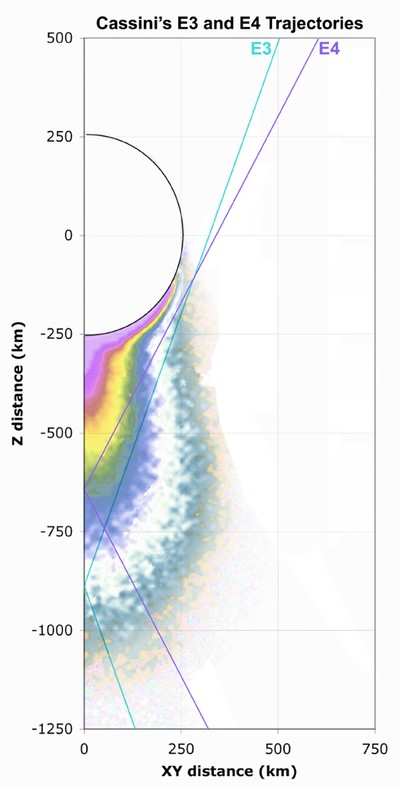 Enceladus flyby blog Fractures, or
"tiger stripes," where icy jets erupt on Saturn's moon Enceladus
will be the target of a close flyby by the Cassini spacecraft on
Monday, Aug. 11.
Enceladus flyby blog Fractures, or
"tiger stripes," where icy jets erupt on Saturn's moon Enceladus
will be the target of a close flyby by the Cassini spacecraft on
Monday, Aug. 11.
Cassini will zoom past the tiny moon a mere 50 kilometers (30
miles) from the surface. Just after closest approach, all of the
spacecraft's cameras -- covering infrared wavelengths, where
temperatures are mapped, as well as visible light and ultraviolet
-- will focus on the fissures running along the moon's south pole.
That is where the jets of icy water vapor emanate and erupt
hundreds of miles into space. Those jets have fascinated scientists
since their discovery in 2005.
"Our main goal is to get the most detailed images and remote
sensing data ever of the geologically active features on
Enceladus," said Paul Helfenstein, a Cassini imaging team associate
at Cornell University in Ithaca, NY. "From this data we may learn
more about how eruptions, tectonics, and seismic activity alter the
moon's surface. We will get an unprecedented high-resolution view
of the active area immediately following the closest approach."
Seeing inside one of the fissures in high resolution may provide
more information on the terrain and depth of the fissures, as well
as the size and composition of the ice grains inside. Refined
temperature data could help scientists determine if water, in vapor
or liquid form, lies close to the surface and better refine their
theories on what powers the jets.
Imaging sequences will capture stereo views of the north polar
terrain, and high resolution images of the south polar region will
begin shortly after closest approach to Enceladus. The image
resolution will be as fine as 7 meters per pixel (23 feet) and will
cover known active spots on three of the prominent "tiger stripe"
fractures.

In addition to mapping the moon's surface in visible light as
well as infrared and ultraviolet light, Cassini will help determine
the size of the ice grains and distinguish other elements mixed in
with the ice, such as oxygen, hydrogen, or organics.
"Knowing the sizes of the particles, their rates and what else
is mixed in these jets can tell us a lot about what's happening
inside the little moon," said Amanda Hendrix, Cassini ultraviolet
imaging spectrograph team member at NASA's Jet Propulsion
Laboratory, Pasadena, Calif.
Other instruments will measure the temperatures along the
fractures, which happen to be some of the hottest spots on the
moon's surface.
"We'd like to refine our numbers and see which fracture or
stripe is hotter than the rest because these results can offer
evidence, one way or the other, for the existence of liquid water
as the engine that powers the plumes," said Bonnie Buratti of JPL,
team member on Cassini's visual and infrared mapping
spectrometer.

Cassini discovered evidence for the geyser-like jets on
Enceladus in 2005, finding that the continuous eruptions of ice
water create a gigantic halo of ice and gas around Enceladus, which
helps supply material to Saturn's E-ring. This marks Cassini's
second flyby of Enceladus this year. During Cassini's last flyby of
Enceladus in March, the spacecraft snatched up precious samples and
tasted comet-like organics inside the little moon. Two more
Enceladus flybys are coming up in October, and they may bring the
spacecraft even closer to the moon. The Oct. 9 encounter is
complimentary to the March one, which was optimized for sampling
the plume. The Oct. 31 flyby is similar to this August one, and is
again optimized for the optical remote sensing instruments.
 Airbus Racer Helicopter Demonstrator First Flight Part of Clean Sky 2 Initiative
Airbus Racer Helicopter Demonstrator First Flight Part of Clean Sky 2 Initiative Diamond's Electric DA40 Finds Fans at Dübendorf
Diamond's Electric DA40 Finds Fans at Dübendorf ANN's Daily Aero-Term (04.23.24): Line Up And Wait (LUAW)
ANN's Daily Aero-Term (04.23.24): Line Up And Wait (LUAW) NTSB Final Report: Extra Flugzeugbau GMBH EA300/L
NTSB Final Report: Extra Flugzeugbau GMBH EA300/L Classic Aero-TV: 'Never Give Up' - Advice From Two of FedEx's Female Captains
Classic Aero-TV: 'Never Give Up' - Advice From Two of FedEx's Female Captains





